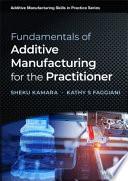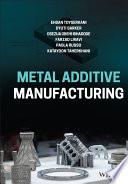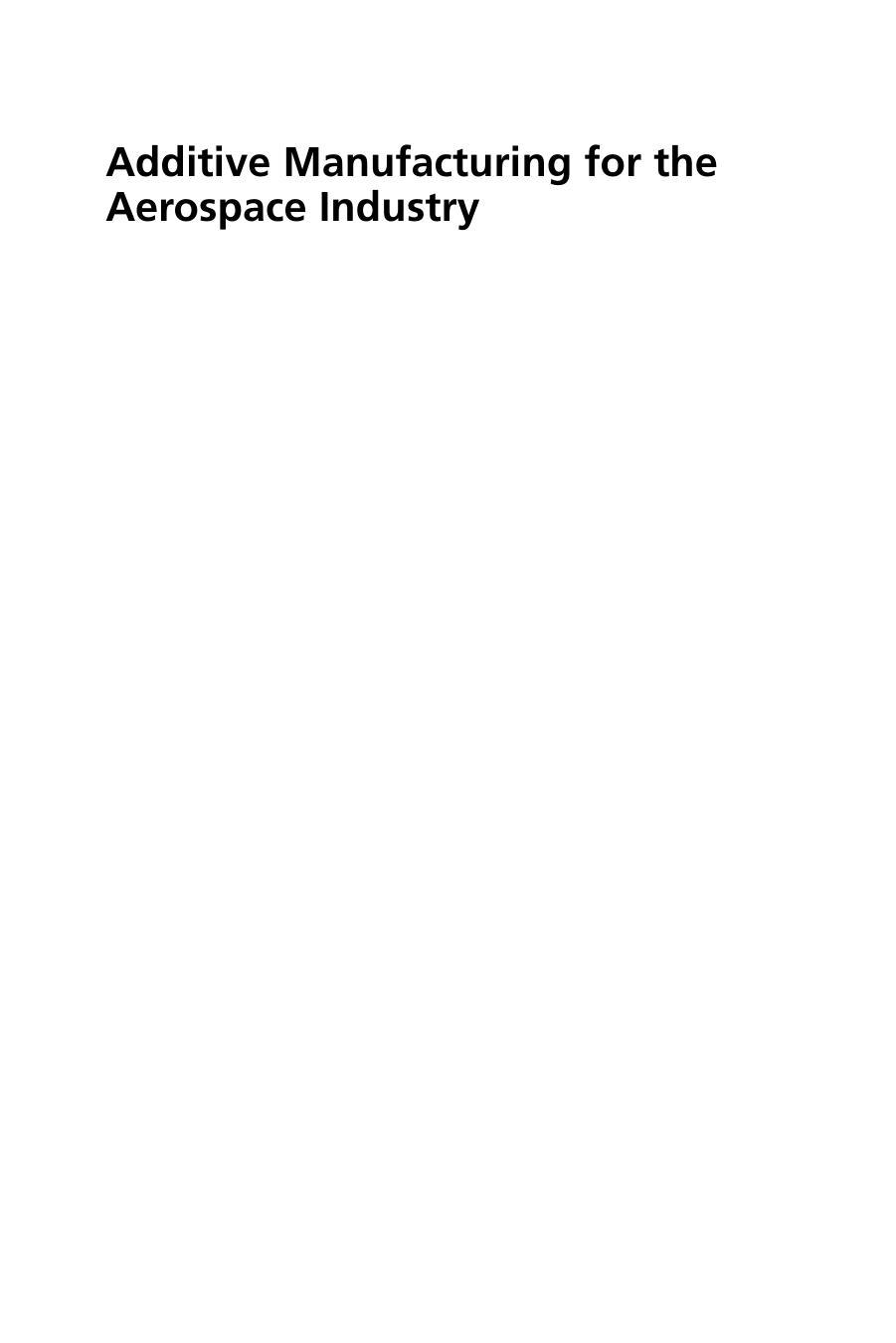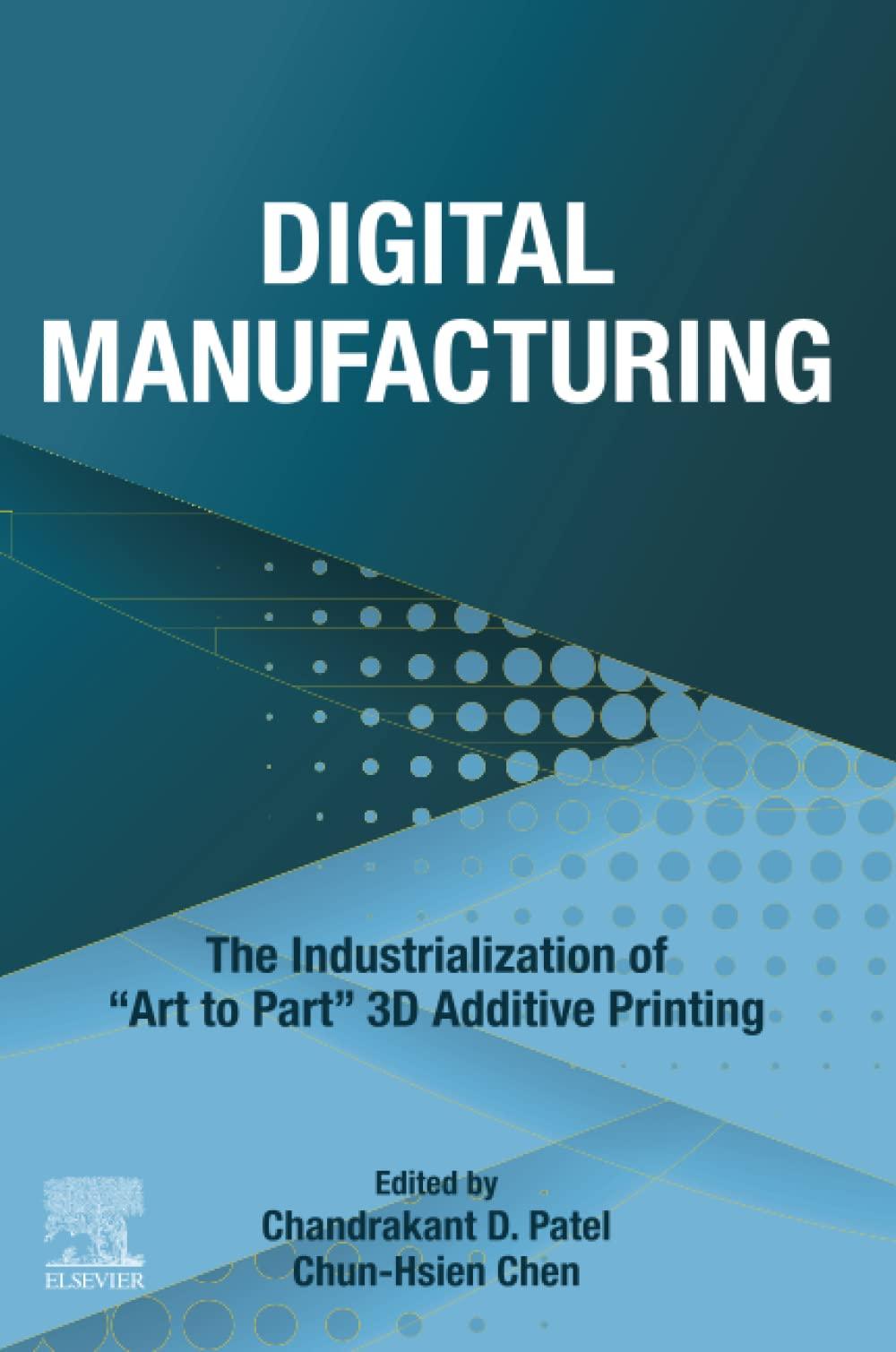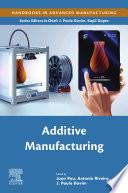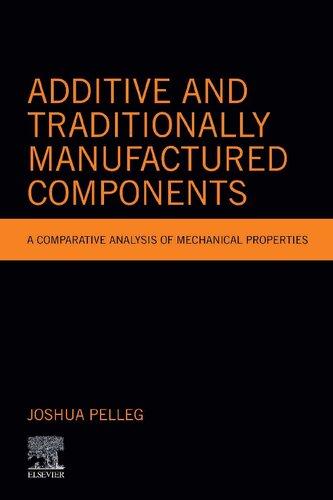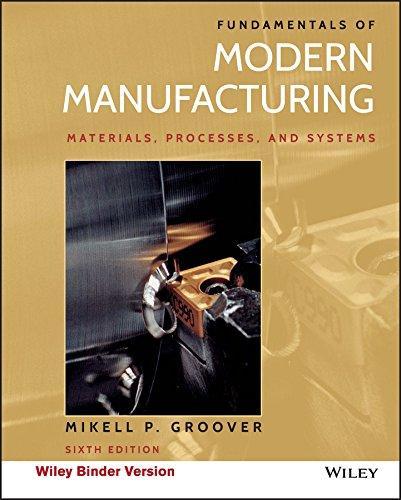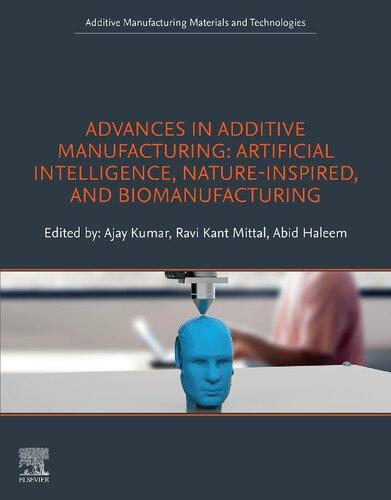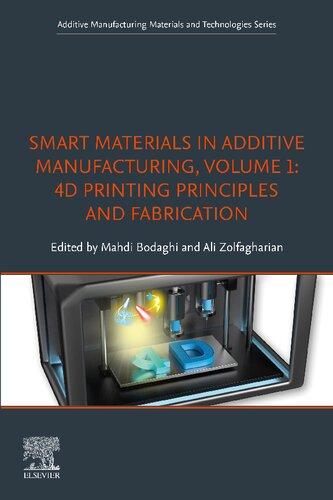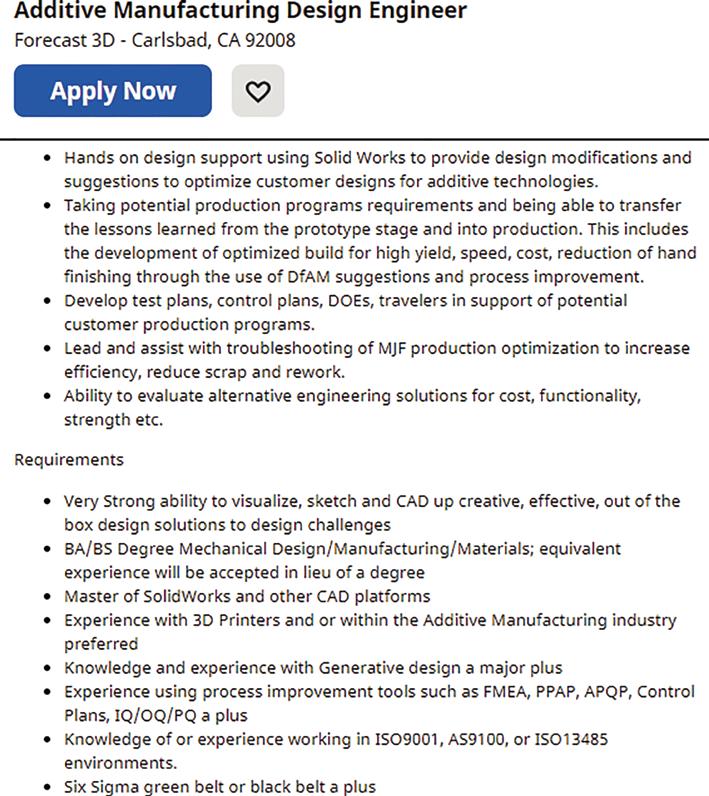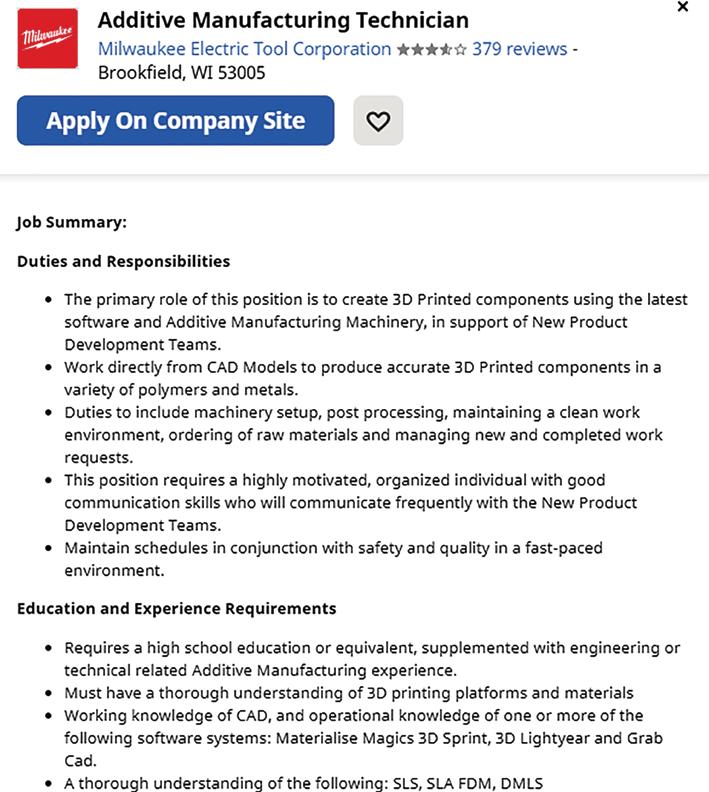Introduction: Moving into Additive Manufacturing
Case Introduction: Current work roles in manufacturing and how they change in AM
Great West Manufacturing (GWM), a medium-size manufacturing firm, recently experienced a change in leadership. The board of directors has charged the new CEO, Sherman Potter, to explore and implement additive manufacturing (AM) to better prepare the firm for long-term viability in their increasingly competitive manufacturing space. The new CEO has made it clear that GWM will continue to manufacture the current line of recreation and athletics end-user products but would like to expand operations to include new opportunities facilitated by AM. As part of the exploration effort, Potter assigned Pete Granger (manufacturing process engineer), Bob Nelson (design and materials engineer), Edgar Remmins (manufacturing technician), and Roxanne Jensen (compliance, testing, and quality control engineer) to the AM Pilot Project team. Their charge is to investigate the knowledge and skills
Fundamentals of Additive Manfacturing for the Practitioner, First Edition. Sheku Kamara and Kathy S. Faggiani © 2021 John Wiley & Sons, Inc. Published 2021 by John Wiley & Sons, Inc.
needed to support additive manufacturing at GWM and formulate a plan to conduct an additive manufacturing pilot test at GWM.
In their first meeting, each team member revealed that s/he had minimal understanding of additive manufacturing with some familiarity with 3D printing concepts. The team’s experience in traditional manufacturing ranged from 2 to 24 years in their respective career areas. The group decided to start by preparing a list of GWM’s manufacturing roles and responsibilities to compare current talent to the knowledge and skills needed for additive manufacturing. Their focus would then shift to exploring additive manufacturing and 3D printing (AM) requirements and processes in preparation for developing a proposal to initiate a pilot project within GWM.
INTRODUCTION
Imagine the year is 2025. The world has quelled COVID-19, the United States has convinced many American manufacturers to move production back to the states, and focused financial investments have spurred significant ongoing growth in the manufacturing sector. Simultaneously, the manufacturing workforce has suffered a hit from the loss of seasoned employees through retirement. Manufacturing has had limited success in recruiting high school and college graduates and is struggling to find employees with the right skillsets to advance additive manufacturing and other emerging production approaches. Fortunately, many great opportunities for exciting work and career growth exist for those who choose a manufacturing career path. While you may have significant experience in different aspects of manufacturing as a manufacturing practitioner, are you ready to meet the challenge of implementing additive manufacturing technologies and processes in the next four to five years?
In the early 1980s, Chuck Hall produced the first stereolithography part, and the following year filed a patent for the Stereolithography Apparatus (SLA). Figure 1.1 displays the first SLA machine and printed part. Additive manufacturing, previously termed rapid prototyping, was officially started when 3D Systems introduced the first commercially available AM system, the SLA-1, in 1987. Various terms referred to additive manufacturing until 2009 when the ASTM F42 committee formed supported by SME’s RTAM community. In 1993, researchers at the Massachusetts Institute of Technology (MIT) patented “three-dimensional printing techniques,” which specifically referenced binder jetting (Sachs, Haggerty, Cima and Williams, 1993). The patent defined the process as: . . .making a component by depositing a first layer of a fluent porous material, such as a powder, in a confined region and then depositing a binder material to selected regions of the layer of powder material to produce a layer of bonded powder material at the selected regions. (US Patent US5204055A, Abstract)
Three-dimensional printing, abbreviated as “3DP” or “3D printing,” has evolved and is now used to refer to inkjet-based, low-cost, hobbyist 3D printers. 3D printing is considered synonymous with additive manufacturing. In general, industry insiders use additive
Figure 1.1 First Stereolithography Machine and First 3D Printed Part
Source: Courtesy of 3D Systems, Inc.
manufacturing or AM, and the public typically uses 3D printing or 3DP to refer to the industry. For this book, both terms refer to the broad range of technologies and processes that comprise additive manufacturing.
Additive manufacturing and 3D printing (AM) technologies began to appear in the 1980s and have since become a significant force for revolutionizing product design, production process efficiency and effectiveness, supply chains, and innovation processes. According to Grand View Research (2020), the global AM market will exceed $35 billion by 2027. North America will likely maintain the largest market share of around 35%.
The primary business drivers for rapid growth and investment in AM continue to be enhanced product manufacturing and reduced time to market.
Continued growth and proliferation of AM are expected, with two key challenges that may hamper growth over the coming decade:
1. An overzealous focus on prototyping and low-volume production prevents organizations from realizing AM benefits at all phases of the manufacturing process.
2. Lack of a skilled workforce hampers the opportunities enabled by evolving technologies and processes.
Misguided Focus Prevents Realization of AM Benefits
AM was initially used in prototyping and to produce complex customized or lowvolume production parts. These focused applications of AM led to the limited adoption of additive manufacturing technologies. For example, consider traditional injection
molding, where a liquid polymer injects into a mold. When evaluated for use in injection molding, the AM focus tends to address increased part complexity, eliminate the mold, or incorporate conformal cooling, multimaterial or gradient-material usage, and speed. There is frequently a failure to consider the application and benefits in the other injection molding elements enabled by AM. In many circumstances, additive manufacturing is critical in providing elaborate fixtures, conformal cooling, mold inserts, and other support areas of the injection molding process. The aerospace and medical industries, which focused on prototyping in their initial AM application, provide another example. These industries realized significant cost savings and reduced lead-times by leveraging the technologies for design verification or presurgical models. However, other significant advantages exist for organizations that push past this initial narrow scope of AM applications.
The shift to AM requires considerable capital investment. For manufacturing firms to adopt these evolving technologies, key decision makers need to understand and leverage the broad range of benefits from more widespread use and application of AM technologies across the entire manufacturing process. Industries will only realize the value-add of AM through the work of a well-prepared and innovative workforce who can make it happen!
Lack of Skilled Workforce Limits Ability to Take Advantage of Opportunities
A skilled workforce is an essential component to exploit AM in any manufacturing and production setting fully. It is the existence of qualified employees who understand how to apply these technologies to current processes to improve and innovate. Research in over 400 manufacturing firms by Deloitte and The Manufacturing Institute revealed that the number of new manufacturing jobs would grow by almost 2 million workers by 2028 (Giffi et al. 2018). Furthermore, more than half of open positions in 2028 could go unfilled due to boomer retirements, misperceptions of manufacturing work, and new skillsets required to work with advanced manufacturing technologies.
In response to the well-publicized manufacturing skills gap and workforce shortages, various education and training initiatives in AM have developed. However, most of the efforts have attracted new generations of workers through high school, two-year trade and technical school, and four-year university programs. Current manufacturing practitioners rely on vendor-specific training, professional association workshops, on-the-job experimentation and training, and certification opportunities as venues for acquiring the necessary AM skills. Unfortunately, the efforts intended to address the manufacturing skills gap appear to have fallen short. A recent update to the Deloitte skills gap study indicated that workers’ shortfall for available manufacturing jobs might be even higher than the original 2 million estimated (Wellener et al. 2020). A national desire to return the manufacturing of critical goods to the US following the COVID-19 pandemic may further exacerbate the manufacturing workforce shortage in the coming years.
This book prepares current manufacturing practitioners to move from traditional manufacturing practices to incorporating AM technologies and processes in their
skillsets by providing a broad foundation for further learning. Existing additive manufacturing books and much available training for practitioners focus on the technical aspects of additive manufacturing and 3D printing technologies and techniques without assisting the practitioner in bridging the knowledge gap. This book’s focus is to provide an end-to-end introduction covering all AM technologies and processes to allow the reader to develop a foundation for implementation in any manufacturing role while also broadening understanding of the scope of applications possible. Building a basic understanding of AM technologies and processes while providing broad coverage of potential applications will allow practitioners to more easily transition to the much-in-demand additive manufacturing workforce and leverage evolving technologies within their organizations.
Vital elements of additive manufacturing are introduced in upcoming chapters with enough technical details to provide the practitioner with a background to participate in the discussion of initiatives in their organizations and analyze the solutions presented. The remainder of this chapter covers an overview of manufacturing processes and examples of the unique applications facilitated by AM. A discussion of how traditional manufacturing job roles change in AM and suggestions for additional training and development follows. The end of the chapter provides a roadmap and recommendations for using the book.
AM Notable 1.1 - Are You Ready for Industry 4.0?
Industry 4.0, known as the new digital industrial revolution, integrates cloud computing, cognitive computing, the Internet of Things, and cyber-physical systems to automate and exchange data in manufacturing. This new industrial revolution enables unprecedented communication between products, means of production, and the humans involved. Software focused on traditional manufacturing limited AM’s ability to reach its potential, but recent developments address AM’s unique issues. HP and Dyndrite
recently announced an advanced software solution to support end-to-end AM processes and management solutions. It also connects to popular third-party software tools used in manufacturing (HP’s Universal Build Manager Powered by Dyndrite, 2020).
What does that mean for the manufacturing workforce? It means almost every manufacturing employee will need to understand and use advanced systems in their work, so better sharpen up those technical skills!
MANUFACTURING PROCESSES
Manufacturing processes comprise four broad process categories: formative, subtractive, additive, and hybrid, used to produce a part or finished product. Figure 1.2 illustrates these categories. A general description of each type appears below, and specific examples of manufacturing processes included in each category are listed and described in Table 1.1:
For mative
SubtractiveAdditive
Figure 1.2 Types of Manufacturing Processes
Hybr id
Source: Shutterstock.com (Formative, Subtractive, Additive); Hybrid image courtesy of Concurrent Technologies Corporation.
Table 1.1 Manufacturing Processes
Formative
Casting is the process of pouring liquid material, typically heated from solids, into a mold cavity to create the desired shape. This process is mostly used for metals. Investment and sand-casting processes are commonly used for metals.
Forming is the process of creating a desired metal part ramming the metal into the desired shape using a hammer or die. The material can be heated or at room temperature, depending on the process.
Molding is the process of pouring liquid material, heated from solids, into a mold under pressure, to create the desired shape. Die casting is for metals and injection molding for plastics. Both processes inject the material under high pressure and produces parts with superior surface finishes.
Stamping is the process of using a die, with compressive forces, to create a desired shape from a sheet metal. The process uses different forming techniques to produce complex parts.
Subtractive
Computer Numerical Control (CNC) is the process of using computer programming to control a cutting tool in precise movements to achieve a desired shape.
Drilling is the process of using a rotary cutting tool to create a hole into an object. The cutting tool referred to a drill bit, spins at different speeds, depending on the material, to remove material by shearing and extrusion. The material can be made of metal, plastic, or wood.
Milling is the process of removing material from an object using a rotary cutting tool to the desired shape. The object can be cut from different angles and axes.
Turning is the process of removing material from an object as it rotates to create a cylindrical part. The cutting tool is pressed against the rotating object to remove material vis shearing.
Table 1.1 (Continued)
Additive
Binder jetting is the process of fusing powdered material with a binder using printheads. The material can be ceramic, plastic, or metal.
Directed energy deposition is the process fusing metal filament or powder using a laser or electron beam as the powder is sprayed or the filament extruded. The process can fuse multiple powdered material at the same time or in sequence using multiple nozzles.
Material extrusion is the process fusing metal or plastic material by heating and extruding the filament. Bonding occurs as the material cools down to a solid.
Material jetting is the process fusing liquid material, typically thermosets, by spraying droplets of the material through a printhead.
Powder bed fusion is the process of fusing metal or plastic powder using a laser or electron beam on a flat plate.
Sheet lamination is the process of fusing layers of material and using a cutter or mill to achieve the desired shape.
Vat photopolymerization is the process of fusing liquid material using an ultraviolet light, in form of a laser of projection, to create the desired from a vat.
Hybrid
Directed energy deposition + CNC is the process of fusing powdered metal using a laser within a CNC machine to build layers of the part whilst machining after a few layers to achieve the accuracy and surface finish of the subtractive process and higher complexity of the additive process.
Powder bed fusion + Milling is process of fusing powdered metal using a laser on a bed of powder and machining the inside and outside surfaces every 10 layers. This process allows the creation of conformal cooling channels within a mold and deep cuts within the part, only possible with other machining processes like electrical discharging machine (EDM).
Sheet lamination + CNC Milling is process of fusing thin metal foils using ultrasonic welding and machining the inside and outside surfaces every few layers. This process allows the creation of gradient material, including different metal combinations, internal cooling channels and capability to embed sensors and electronics within a part.
Source: Original, Kamara and Faggiani, 2020.
• Formative. Formative manufacturing processes include those that shape the material into the desired form and may use a mold or a die. Materials used may be melted, heated, or at room temperature, depending on the specific process. In general, formative techniques are used for high volumes of the same part and support lower part costs.
• Subtractive. Subtractive manufacturing processes remove material from a solid block or a near-net shape to achieve the desired size and geometry of the finished object. These techniques may use computer numerical control (CNC) machines, plasma torches, sheers, or other material-removal equipment. Parts or products produced by subtractive processes typically have simple geometry and are made in medium volumes.
• Additive. Additive manufacturing processes use computer-aided design (CAD) files to create ultra-thin digital slices of the desired shape, built-up by bonding layers of material together based on the slices to form an object. Additive manufacturing enables complex part geometry and typically produces parts in low to medium volumes.
• Hybrid Hybrid manufacturing processes achieve the desired shape of an object by combining either formative or subtractive processes with additive techniques sequentially within the same machine. This approach combines the complexity possible with additive methods and the superior finishing possible through other processes.
TRADITIONAL AND AM JOB ROLES
Manufacturing jobs generally include work in any process necessary to turn raw materials or components into new products. Broadly defined, classic manufacturing work falls into the following categories:
• Process. Work to select and implement the desired production process for parts or products; performed by a manufacturing engineer.
• Design. Work to conceptualize and design parts or products and optimize the design to leverage the selected process; performed by design engineers.
• Material. Work to identify and select the correct material for parts or products, particularly where the material must meet certain conditions; performed by material engineers.
• Compliance. Work to understand and ensure that parts or products meet ethical, safety, or regulatory standards; performed by a compliance engineer or compliance manager.
• Testing. Work to create a process or method to test and validate the part or product to ensure specifications are met; frequently performed by a test engineer or test analyst.
Various job titles exist within these general categories, and some roles may overlap among the types. Table 1.2 includes typical manufacturing job titles and brief descriptions from the US Bureau of Labor Statistics in the first two columns. The first column also shows new job titles for AM-specific roles emerging in job postings. Let’s consider how traditional roles may need to evolve or be enhanced in additive manufacturing.
Table 1.2
How Additive Manufacturing Changes Job Roles
Role Traditional Manufacturing In Additive Manufacturing
Manufacturing Production Technicians
New Job Titles:
• Field Service Technician (AM)
Manufacturing Engineers
New Job Titles:
• Additive Manufacturing Process Engineer
Set up, test, and adjust manufacturing equipment.
Design, integrate, or improve manufacturing systems or related processes.
• New technologies
• New techniques (machine calibration, build preparation, part finishing, etc.)
• New IT data and software skills
• New technologies
• More collaboration with commercial/design engineers
• Rethink fabrication and modeling
• Utilize DFAM (design for additive manufacturing)
• New materials
Manufacturing Engineer Technologists
New Job Titles:
• Additive Manufacturing Technologist
Industrial Production Managers
New Job Titles:
• Senior Additive Manufacturing Engineer
• Application Development Technical Service Manager (AM)
Develop tools, implement designs, or integrate machinery, equipment, or computer technologies to ensure effective manufacturing processes.
Plan, direct, or coordinate the work activities and resources necessary for manufacturing products in accordance with cost, quality, and quantity specifications.
• New technologies
• Innovate with jigs/fixtures
• More collaboration with manufacturing, manufacturing production technicians, and commercial/design engineers
• New technologies
• Technical and management cross-functional competencies
(Continued)
Chapter 1: Introduction: Moving into Additive Manufacturing
Table 1.2 (Continued)
Role
Commercial and Industrial Design Engineers
New Job Titles:
• Senior Additive Manufacturing Engineer
Traditional Manufacturing In Additive Manufacturing
Develop and design manufactured products, such as cars, home appliances, and children’s toys. Combine artistic talent with research on product use, marketing, and materials to create the most functional and appealing product design.
• New design processes and technologies
• New design programs
• New materials
• New IT data and software skills
• Rethink fabrication and modeling
• More collaboration with manufacturing engineers and production technicians
• Utilize DFAM (design for additive manufacturing)
Finisher/Manufacturing Specialist
New Job Title: Machine Operator
Use customer and design specifications to make products visually and dimensionally acceptable to consumer.
Machine Operators and Tenders
New Job Titles:
• Additive Manufacturing Technician
Material Engineers
New Job Titles:
• Materials Fabrication and Process Engineer
• Materials and Process Engineer
Set up, operate, or tend machines, such as glass forming machines, plodder. machines, and tuber machines, to shape and form products, such as glassware, food, rubber, soap, brick, tile, clay, wax, tobacco, or cosmetics.
Evaluate materials and develop machinery and processes to manufacture materials for use in products that must meet specialized design and performance specifications. Develop new uses for known materials.
• New AM technologies or machines to enhance visual and dimensional properties, that both produce and finish parts
• Perform both AM operator and finishing functions in same area
• New technologies
• New techniques (machine calibration, build preparation, part finishing, etc.)
• New IT data and software skills
• 3D scanning and non-destructive testing technologies
• Part finishing, may replace separate finishing role
• New materials
• New parts/material/process certifications
• New technologies
Table 1.2 (Continued)
Role Traditional Manufacturing In Additive Manufacturing
Quality Control Managers/Analysts
New Job Titles:
• Quality/Validation Engineer (AM)
Compliance Manager
New Job Titles:
• Senior VP, Quality, Compliance, and Regulation (AM)
Tester/Inspector
New Job Titles:
• Additive Manufacturing Specialist
Plan, direct, or coordinate quality assurance programs. Formulate quality control policies and control quality of laboratory and production efforts. Conduct tests to determine quality of raw materials, bulk intermediate and finished products.
Plan, direct, or coordinate activities of an organization to ensure compliance with ethical or regulatory standards.
Inspect, test, sort, sample, or weigh nonagricultural raw materials or processed, machined, fabricated, or assembled parts or products for defects, wear, and deviations from specifications.
• New IT data and software skills
• New materials and processes
• In areas where part consolidation is used, 3D scanning and other non-destructive metrology methods are a requirement to validate the parts.
• New parts/process/material certification
• New techniques and methods for more complex parts
• In areas where part consolidation is used, 3D scanning and other non-destructive metrology methods are a requirement to validate the parts.
Source: Content for traditional job titles and work descriptions derived from O*Net OnLine Occupations. www.onetonline.org/ (accessed 11 May 2020).
The rise of additive manufacturing represents a paradigm shift in manufacturing and production. While the technologies and processes are groundbreaking and unique, the standard work categories remain the same. However, there are new knowledge, skill, and behavior requirements needed within each category. The new requirements are presented and described below, as well as summarized in Table 1.2.
New Technologies, Processes, and Materials
AM is comprised of a wide variety of technologies and processes that are related to different material capabilities, as described in the section on Manufacturing Processes. Given the proprietary nature of AM equipment and associated processes, each specific platform’s education and training are vendor-provided. Specific process requirements may vary by equipment, material, or AM application to a given solution, and manufacturing
engineers may need to think out of the box about modeling and fabrication. AM part finishing is automated or manual, with more significant automated finishing occurring to avoid the variation possible in manual processes. Material acquisition, storage and handling, safety issues, reuse or recycling, and other regulations vary by material and may differ significantly from traditional raw materials.
New Techniques
In addition to becoming experts with new machines and equipment, technicians and operators will need to apply modern machine calibration techniques and adjustments. New tasks and processes in preparing for the build of parts or products will be necessary and new methods for removing parts or products from AM machines and conducting various post-processing and finishing tasks.
New IT Data and Software Skills
Acquiring, recording, updating, and maintaining 3D data as input to the AM manufacturing process will present the opportunity to learn and apply new IT and data management skills. The ability to design parts or products with greater complexity for increasingly sophisticated systems will enable more nondestructive testing, quality control inspections with 3D scanning, and the generation of more useful data.
More Communication and Collaboration
AM can significantly reduce the time from design to production, resulting in a greater dependency between the design and engineering processes and technicians. The compressed time frame and dependencies indicate the need for more and better communication between design engineers, manufacturing engineers, and production technicians than may exist in some traditional manufacturing processes. Increased communication also minimizes errors due to unintended consequences. The speed of the process and greater complexity of designs account for some mistakes as operators may not distinguish between design intent and an error.
New Design Processes and Technologies
Additive manufacturing opens a new range of possibilities that make greater complexity in design and production easier to achieve; however, current traditional design thinking may create “blinders” for design engineers. Engineers will need to develop skills using new design processes and technologies to leverage AM process power. The inherent variability within the AM process provides the opportunity for gradient and predictable mechanical properties instead of discrete, as is evident in other methods. For example, a change in laser power within the same part and on the same build platform produces composite properties using the same material as the parameters change layer-wise. The manufacturing engineer now must collaborate with
design engineers, as part complexity and consolidation require the development of new processes and techniques. For example, six individual components consolidated into one part with increased functionality affects other processes downstream.
New Tooling Capabilities
The development of jigs and fixtures for additive manufacturing and more traditional processes is possible using AM. Manufacturing engineers and technicians will need to acquire the skills and knowledge to design and use AM-produced tools and fixtures rapidly. The increased level of complexity possible within AM has enabled designs for jigs and fixtures impossible through traditional methods.
Enhanced Use of 3D Scanning and Nondestructive Testing
A standard tool in modeling and design is poised to assume an even more significant role with AM’s ability to produce increasingly complex objects. The 3D models created from scanning and modified for AM can facilitate reverse engineering of existing traditionally made parts. The complexity enabled by AM can reduce the number of individual components required in a part design. Design engineers will need to enhance their skills working with scanned images and reverse engineering. Quality verification of AM parts is best achieved by nondestructive testing (NDT), given the potential variability inherent in AM processes. Test and compliance engineers will need to become versed in NDT.
New Certification Requirements
Existing parts and products have been subject to quality, safety, and regulatory certification through production with traditional manufacturing products and materials. AM adds a whole new dimension, requiring new certifications for AM processes, materials, and parts. Compliance engineers, design engineers, and industrial production managers will need to work through required certifications.
AM Notable 1.2 - Can You Hear Me Now?
The disruptive change embodied in a move to AM doesn’t involve only technology, process, materials, and the way work occurs. It also means that people and communication are more critical than ever. Advanced software
can facilitate communication between equipment and processes, and even between technology and people, but the person-to-person connection is more important than ever. Sound workflow systems can alert workers
(Continued)
of pending jobs, smooth the production flow, and indicate anomalies before problems occur. But only strong human communication can help solve complex design problems, turn opportunities into creative innovations, and build a healthy work environment.
What does this mean for you?
Don’t focus so much on learning
new AM technologies and processes that you ignore opportunities to develop your interpersonal communication and team skills. Soft skills matter – arguably more in an automated AM world than in traditional manufacturing, especially during the turmoil and ambiguity that accompany disruptive change.
In addition to the job roles and titles described in Table 1.2, new career opportunities are also emerging. For example, the job website SimplyHired.com listed an open position for an Associate Data Engineer – Additive Manufacturing (retrieved 12 June, 2020). According to the job description, the work involves using IT to collect, track, visualize, and access modeling, process metallurgy, and testing data for AM and materials science researchers. The second example of AM’s emerging jobs is the Additive Manufacturing Design Engineer, a role involved with driving Design for Additive Manufacturing (DfAM) and AM-related solution development and exploration. An excerpt from the job description found at indeed.com (retrieved 5 November 2020) for an AM manufacturing design engineer appears in Figure 1.3. It is likely that as AM applications continue to expand and increase across industries, many new AM career opportunities like this one develop.
AM Notable 1.3 - Your Job Morphs to AM
Wondering what your job will really be like in an AM world? See the details in the Indeed.com snippets of actual job openings in Figures 1.4–1.6:
If you’re a manufacturing technician in traditional manufacturing, consider the additive roles described in Figure 1.4 or Figure 1.5.
If you’re a manufacturing engineer, your AM role might look something like the additive role described in Figure 1.6.
Note that your prior manufacturing experience is expected and valued in the new roles. Also, note that broad AM knowledge, like the content presented in this book, is either expected or preferred.
Figure 1.3 Additive Manufacturing Design Engineer Job Description
Source: Excerpt from Indeed.com (accessed 5 November 2020).
Chapter 1: Introduction: Moving into Additive Manufacturing
Source: Excerpt from Indeed.com (accessed 5 November 2020).
Figure 1.4 AM Technician at Tesla
Figure 1.5 AM Technician at Milwaukee Electric Tool
Source: Excerpt from Indeed.com (accessed 5 November 2020).
Chapter 1: Introduction: Moving into
Figure 1.6 Additive Mold Manufacturing Engineer at Arris Composites
Source: Excerpt from Indeed.com (accessed 5 November 2020).
Case Conclusion: Developing Knowledge and Skills in AM
After the team at Great West Manufacturing (GWM) completed their research assignments to investigate additive manufacturing and identify how the traditional manufacturing jobs at GWM might change due to moving into AM, they met to review their key findings and suggestions. The executive summary they prepared contained the following key points:
• All key traditional manufacturing jobs will require employees to acquire new knowledge and skills for GWM to move into AM successfully. Some employees nearing retirement may not be interested in moving into AM, or more recent hires may already have some educational background in AM. Everyone at GWM needs to understand the new manufacturing paradigm
and shift away from the traditional manufacturing mindset. Various positions will require more in-depth AM knowledge, but all will need a strong foundation.
• Design engineers, manufacturing technologists, and machine operators will experience the most significant level of change in their job roles. Vendorspecific training for technicians and operators is needed. Design engineers will need to explore new design processes and programs to address the complexity enabled by AM. AM introduces new concepts to design and materials engineers. Part design and build process parameters drive material properties more so than in any other manufacturing process. Understanding the technologies and material selection allows the team to leverage the AM process both as a final product and as a tool in aiding the existing or potential new techniques that are derived.
• Manufacturing engineers and industrial production managers will need to plan carefully to incorporate AM in existing production processes or replace existing methods.
• The manufacturing technician’s role requires a deeper understanding of software since the CAD inputs and processing play a crucial role in the system’s functioning. In AM, there is variability within the machine and from machine-to-machine.
• Part design and build process parameters drive material properties, a potentially new concept for the design and material engineers. Understanding the technologies and material selection allows the team to leverage the AM process both as a final product or as a tool in aiding the existing or potential new techniques that are derived.
• Testing, compliance, and quality control will be impacted by the need for new processes to evaluate complex parts and gain needed certifications.
• Better communication and collaboration will need to be instilled across the organization to ensure a tight connection between design engineers, manufacturing engineers, and technologists, technicians, and operators.
• At a minimum, the team needs to have a common understanding of additive manufacturing technologies to provide a neutral basis for comparison to their existing processes. Given the compression of the manufacturing and production time frame and the tight connection among job roles and responsibilities, ensuring all job roles are familiar with the complete end-to-end additive manufacturing processes is critical to GWM’s success. This comprehensive picture will also help employees ensure that AM makes value-added contributions to the current line of manufactured goods. The goal is to innovate and expand on manufacturing operations at GWM.
HOW TO USE THIS BOOK
This book, written for the student, technician, designer, engineer, manager, and other manufacturing practitioners interested in acquiring and applying additive manufacturing technologies and processes within their organization, aims to provide a broad foundation for ongoing learning. It covers all aspects of AM from product design to production and incorporates additive manufacturing technologies in practical, useful, real-world case studies. The case study further illustrates alternative manufacturing technologies and demonstrates additive manufacturing as the preferred method. Chapter 3 describes the AM design process and inputs to AM. Chapter 4 covers the range of materials used in AM, while Chapter 5 presents the technology and methods appropriate for different materials. Chapters 6 and 7 discuss the preparation for the AM build, the build, and related quality factors. Chapter 8 explores a range of AM post-processing activities, including limited coverage of compliance and testing.
As a manufacturing practitioner navigating this book, you will be part of the journey in analyzing opportunities for the application of AM in your organization. Begin by identifying a problem or opportunity for which you would like to explore an AM solution in Chapter 2. You will work through the major decision steps and processes needed to move an AM initiative forward in subsequent chapters. The case study will explain how another organization has addressed challenges and decisions to move AM forward in their organizations. By the end of the book, you should be prepared to make a case for implementing an initial AM project.
REFERENCES
Dyndrite.com (2020). HP’S Universal Build Manager Powered by Dyndrite. www.dyndrite. com/ubm (accessed 9 November 2020).
Grand View Research (2020). 3D printing market worth $35.38 billion by 2027|CAGR: 14.6%. www.grandviewresearch.com/press-release/global-3d-printing-market (accessed 17 May 2020).
Giffi, C., Wellener, P., Dollar, B., et al. (2018). The jobs are here, but where are the people? Deloitte Insights. www2.deloitte.com/us/en/insights/industry/manufacturing/ manufacturing-skills-gap-study.html (accessed 17 May 2020).
Sachs, E., Haggerty, J., Cima, M. and Williams, P. (1993). Three-Dimensional Printing Techniques. 5,204,055A.
Wellener, P., Dollar, B., Ashton Manolian, H., et al. (2020). The future of work in manufacturing. Deloitte Insights. www2.deloitte.com/us/en/insights/industry/ manufacturing/future-of-work-manufacturing-jobs-in-digital-era.html?nc=1 (accessed 17 May 2020).
Chapter 2
